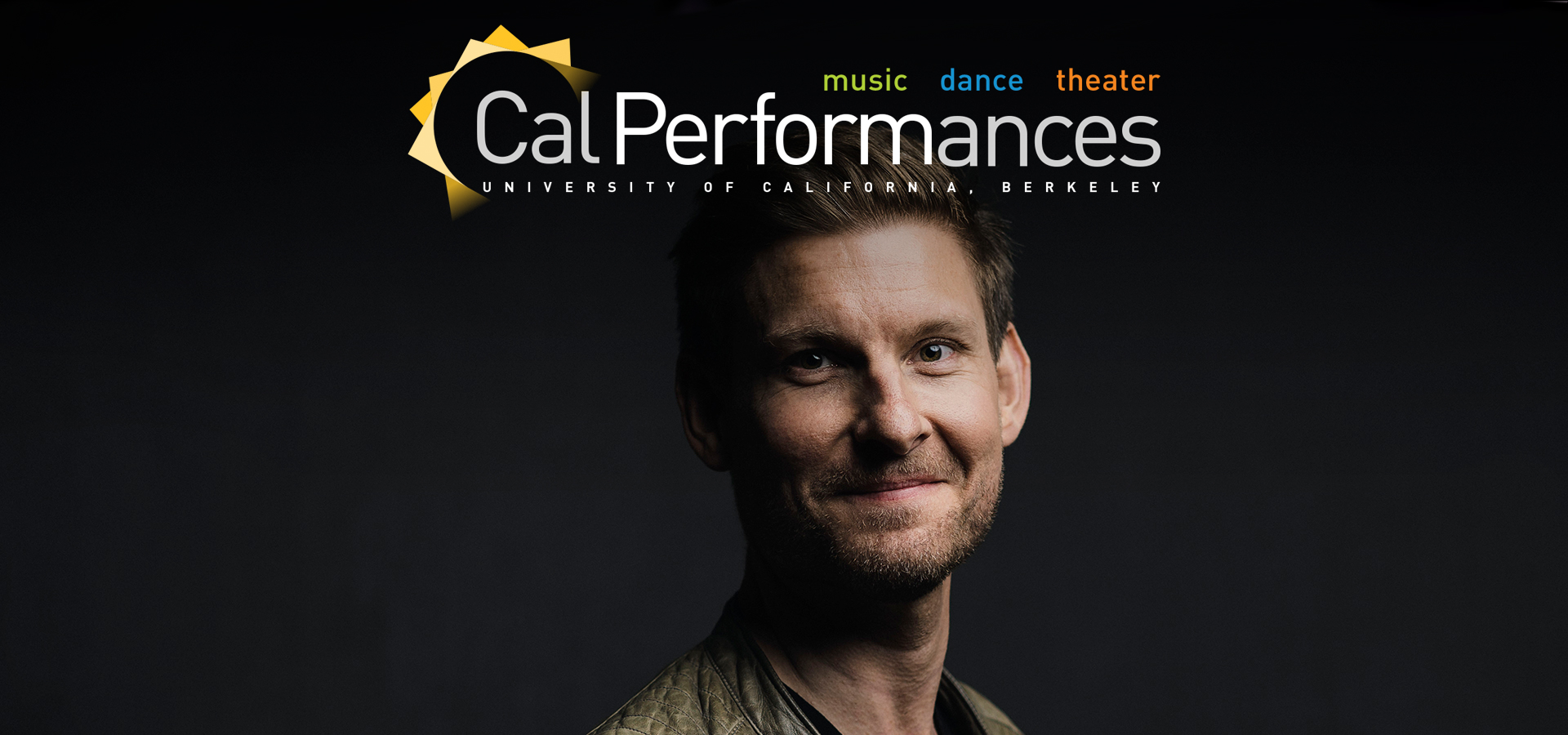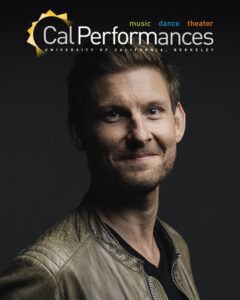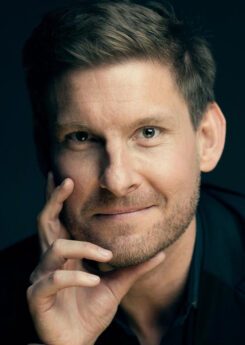Johann Sebastian Bach
Toccata in D minor, BWV 913
The genre of the “Toccata” in Germany traces its roots to at least the 15th century, when the title was used to designate independent keyboard pieces not based on dance types, canti firmi (i.e., borrowed melodies), or vocal models. The term was derived from the Italian word “toccare”—“to touch”—and indicates a style intended to exhibit the player’s virtuosity and manual dexterity. Toccatas continued to be composed in Italy and the northern countries through the following century, when they often incorporated contrasting passages in fugal and free idioms. This type of work reached its zenith in the elaborate and often dramatic organ compositions of Girolamo Frescobaldi (1583, Ferrara –1643, Rome). Later in the Baroque era, the toccata was marked mainly by its rhapsodic, sometimes flamboyant nature and rhythmic animation; Johann Sebastian Bach’s toccatas—five for organ and seven for harpsichord, as well as others incorporated into multi-movement works—are the most magnificent 18th-century examples of the species.
Bach’s dozen independent toccatas are products of his tenure as Organist and Chamber Musician at the court of Weimar between 1708 and 1717. In their virtuosity, melodiousness, and rhythmic vitality, these works show the influence of recent Italian music, which he learned by copying, arranging, and performing pieces by Vivaldi, Marcello, and others. As was typical of the genre, the D minor Toccata, composed around 1710, comprises a number of contrasting sections: an introductory movement in improvisatory style; a tightly reasoned fugue; an introspective Adagio; and a spirited contrapuntal finale.
Wolfgang Amadeus Mozart
Fantasia in C minor, K. 475
As Mozart reached his full maturity in the years after arriving in Vienna in 1781, his most expressive manner of writing, whose chief evidences are the use of minor modes, chromaticism, rich counterpoint, and thorough thematic development, appeared in his compositions with increasing frequency. Such musical speech had regularly been evident in the slow movements of his piano concertos, but in 1785 he dared to compose an entire work (the Concerto No. 20 in D minor, K. 466) in a minor key. At that same time, perhaps the most productive period of his life (12 of his last 14 piano concertos were written between 1784 and 1786), Mozart created a series of three piano works cast in the tragic key of C minor—Sonata, K. 457, completed on October 14, 1784; Fantasia, K. 475, May 20, 1785; and Concerto No. 24, K. 491, April 1786. The Fantasia and Sonata were published together in a single volume by Artaria in December 1785 with a dedication to Therese von Trattner, the composer’s 23-year-old piano student who was the second wife of the 64-year-old court printer and publisher, Johann Thomas von Trattner. Mozart was close to the Trattners during that time, and he hired the ballroom of their palace in Vienna to present his Lenten concerts of 1784. He sent Frau von Trattner a series of letters concerning the proper execution of the Fantasia and Sonata, but those missives have unfortunately been lost (or destroyed—speculation has it that the letters may have referred to some delicate personal matters that associates and family of neither the lady nor the composer wished to have made public); Alfred Einstein said that if they ever turn up, the letters would be among “the most important documents of Mozart’s aesthetic practice.”
The C minor Fantasia consists of five large structural paragraphs played continuously—a portentous opening Adagio that is brought back at the end to round out the work; an unsettled Allegro; a cautious Andantino; a tempestuous Più Allegro; and the closing Adagio. Einstein believed that this tiny anthology of inchoate movements “gives us the truest picture of Mozart’s mighty powers of improvisation—his ability to indulge in the greatest freedom and boldness of imagination, the most extreme contrast of ideas, the most uninhibited variety of lyric and virtuoso elements, while yet preserving structural logic.” (Beethoven’s extraordinary Fantasia in G minor, Op. 77, similarly opens a rare window onto that composer’s manner of improvisation.)
Ludwig van Beethoven
Piano Sonata in C minor, Op. 13, Pathétique (1799)
Among the earliest evidences of Beethoven’s uniquely powerful and daring genius is the Sonata in C minor, Op. 13, which the composer himself nicknamed Pathétique upon its publication in Vienna by Hoffmeister late in 1799. (The only other piano sonata to which he gave a sobriquet was the Lebewohl Sonata, Op. 81a, of 1810.) Beethoven’s music confirms that he used the word to connote something grander, craggier, more majestic than the submissive, melancholy meaning of the English “pathetic.” Indeed, the opening movement of this sonata, with its symphonic breadth of expression, its hammer-blow ferocity, and its shock-cut contrasts, is musical Romanticism already made manifest, a Herculean blow to the fading elegance of the waning century. That Beethoven could serve up such bold iconoclasms to the Viennese nobility speaks not only of his artistic courage and self-confidence, but also of the sophistication of his listeners. The Pathétique was popular immediately, quickly appearing in multiple published editions and arrangements for a variety of ensembles, and it remains among Beethoven’s most performed piano works.
The primary emotion of the opening movement of the Pathétique is inherent in its first gesture—a thunderbolt of C minor, whose tragedy is enhanced by the somber dotted-rhythm chords, the stark contrasts, and the dramatic gestures that follow. The exposition is driven by a barely contained turbulence that rockets its main theme upward through the piano’s register and forces its second theme out of the expected major key into a troubled minor mode. The scalar closing theme—whose downward direction balances the main theme’s rising rocket—carries the expressive intensity to the end of the exposition. The music pauses on an unsettled harmony that leads to the amazing audacity of bridging to the development section by the recall of the powerful music of the introduction. The development section proper, compact and dramatic, refers mostly to a scrap of transitional material rather than to either of the two principal motives, and drives with irresistible force to the recapitulation and the return of the earlier themes. The introduction is once again invoked as the gateway to the coda. The movement ends with a final furious statement of the main theme.
The central Adagio is from another expressive world. In form, it is a rondo (A–B–A–C–A), and “in poetic content,” according to Marion M. Scott in her study of Beethoven, “it is tragedy as the young feel it, with the glamour, urgency, even exaltation, of a Romeo and Juliet. And few southern love-scenes could be more softly glowing than Beethoven’s slow movement, with its almost unbelievable melodic loveliness and velvety tone.” The rondo-form finale returns to the first movement’s quick pace and C minor key, but it is more genteelly melancholy than passionately turbulent.
Franz Schubert
Andantino from Moments Musicaux, D. 780
Schubert was among the first practitioners of the so-called “character piece,” the species of compact, single-movement, sharply etched piano composition designed for the burgeoning home music market in the early 19th century. There grew to be a virtual musical tidal wave of these popular miniatures in the years after Schubert’s death, in 1828—the masterful examples by Chopin, Schumann, Brahms, Liszt, Mendelssohn, Grieg, and others occupy the heart of the piano literature—but the form was still new when he took it up around 1815 to provide keyboard entertainment at the convivial local gatherings, known as “Schubertiads,” that featured his music and performances. Among the most endearing of Schubert’s character pieces are the Moments Musicaux, whose six movements occupied him between 1824 and 1827. They were issued as a set by the Viennese publisher Leidesdorf in July 1828, but two of them had been published earlier—No. 3 (as Air Russe) by Leidesdorf in an Album Musical for Christmas 1824, and No. 6 (Les Plaintes d’un Troubadour) in Leidesdorf’s holiday anthology of the following year. (The title, given in fractured French in the first edition as Momens musicales, appears to have originated with Leidesdorf, not Schubert.) The Moments are modest in length and unassuming in form (three-part structure: A–B–A), yet they embody the quintessential lyricism, harmonic suavity, and emotional appeal that characterize Schubert’s finest creations.
Schubert
Allegretto quasi andantino from Sonata in A minor, D. 537
In June 1816, when he was 19, Schubert received his first fee for one of his compositions (a now-lost cantata for the name-day of his teacher, Heinrich Watteroth), and decided that he had sufficient reason to leave his irksome teaching post at his father’s school in order to follow the life of an artist. He moved into the Viennese apartments of his devoted friend Franz von Schober, an Austrian civil servant who was then running the state lottery, and celebrated his new freedom by composing incessantly, rising shortly after dawn (sometimes he slept with his glasses on so as not to waste time getting started in the morning), pouring out music until early afternoon, and then spending the evening haunting the cafés of Grinzing or making music with friends. These convivial soirées became more frequent and drew increasing notice during the following months, and they were the principal means by which Schubert’s works became known to the city’s music lovers. By the end of 1816, he had finished two symphonies (Nos. 4 and 5), a cantata in honor of the 66th birthday of his counterpoint teacher Antonio Salieri, a Magnificat, a Stabat Mater, and a large number of songs, including “Der Wanderer.” After being inspired by the so-called “Rossini Fever” then sweeping Vienna to compose an Italian-style overture at the beginning of 1817 (D. 556), he turned his attention to the piano, and completed three sonatas by August (and made extensive sketches for an equal number that were never finished), which he played at the Schubertiads and at the homes of wealthy patrons (whose fine pianos he loved to try out).
The sonata’s second movement (Allegretto quasi andantino) follows the returning-refrain-with-contrasting-episodes structure of the rondo (A–B–A–C–A), though the second presentation of the main theme occurs in an unexpected key, one of the many examples of the 20-year-old Schubert tugging at the boundaries of traditional forms.
Clara Schumann
Romance in A minor, WoO 28 (1853)
Goethe called her “a noble phenomenon”; Franz Grillparzer, Austria’s greatest poet and a sensitive musician, was inspired to write a poem titled “When She Played Beethoven’s F minor Sonata”; the prestigious journal Neue Zeitschrift für Musik ranked her as the third greatest pianist of the day, behind only Franz Liszt and Sigismond Thalberg. The object of these encomia was a teenage girl from Leipzig, a dazzling Wunderkind who possessed not only flawless keyboard technique but also extraordinary artistic sensitivity and unswerving dedication to the most elevated principles of the musical art—Clara Wieck. Clara’s father, Friedrich, a noted teacher of piano and voice, operator of a music-lending library and a piano store, and a former preacher, vowed even before the girl was born that he would develop her into a consummate artist, and he showed considerable restraint by not beginning her lessons until she was five. His instruction fell upon a fertile talent—Clara made her public debut at the Leipzig Gewandhaus on October 20, 1828 (she was nine-and-quarter years old), gave her first complete recital two years later, and made her debut international tour the following season. By 1835, she was acclaimed throughout Europe as a child prodigy.
In 1829, the 19-year-old Robert Schumann met Friedrich Wieck, and he was accepted by the pedagogue as a student; the following year, Robert moved into the Wieck household. He was at first amused by his teacher’s gifted daughter, but over the course of the following years, the couple’s relationship developed into true love (“Clara grows more charming, inwardly, outwardly, every day, every hour,” Robert wrote in 1835) and became one of the great romances of the 19th century. That story—Papa Wieck’s nearly irrational resistance to the union, the lovers’ court battle to receive legal permission to marry, their passionate devotion to each other during their 16 years of wedded life, Robert’s mental collapse and untimely death in 1856—is well-known and carefully chronicled in a half-dozen books. Clara put her domestic duties before her professional ambitions during those years (she gave birth to eight children between 1841 and 1854), concertizing only occasionally and composing just a piano trio and a handful of songs and solo piano pieces, including her Variations on a Theme of Robert Schumann in 1853. Following her husband’s death in 1856, she resumed touring and teaching, but never composed again.
In 1853, Clara and Robert met both Johannes Brahms, a promising 20-year-old pianist and composer from Hamburg, and violinist Joseph Joachim, who had just been appointed concertmaster of the Hanover Court Orchestra and would soon become recognized as one of the finest musicians of his generation. Both became life-long friends and professional colleagues. Clara started to compose again at that time after having put creative work aside for the previous six years to tend to her family and her performing career. Her first composition of 1853 was the set of variations (Op. 20) on a theme from Robert’s Bunte Blätter (Colored Leaves, Op. 99) that she wrote as a gift for her husband’s 43rd birthday, on June 8th. She followed that piece with Three Romances for Violin and Piano (Op. 22) for Joachim and then a set of Three Romances for Piano (Op. 21). In April 1855, after Robert had been admitted to the asylum where his life would end the following year, she replaced the first of the Op. 21 pieces with a new movement dedicated to Brahms, who gave her unstinting support and assistance throughout her husband’s final illness. The revised Op. 21 works were published in 1855, but the pensive earlier Romance in A minor was not issued until it was included in a London serial called Girl’s Own Paper in 1891 with the following dedication: “Composed for my loyal Rosalie and commended to her loving care, Clara Schumann, July 1853.” Rosalie Leser, who was blind, was one of Clara’s close friends during the Schumanns’ time in Düsseldorf.
Felix Mendelssohn
Selections from Songs Without Words
Though Felix Mendelssohn was the great Classicist among the prominent early Romantic composers, he was not immune to the new modes of musical expression gaining currency during his time. Among the most important of those innovative genres was the character piece for piano, which Chopin, Liszt, Schumann, and a battalion of lesser lights made the vehicle for some of their most ardent and adventurous creative endeavors. About half of Mendelssohn’s hundred or so character pieces were collected together in his eight volumes of Songs Without Words. Though, as Busoni, George Bernard Shaw, and others have observed, their elegant style and purity of line challenge the greatest of performers, the Songs Without Words were intended primarily for the 19th-century’s burgeoning home music market for convivial rendition around the parlor piano. (It was then de rigueur for the daughter of every proper household in England and northern Europe to acquire sufficient piano skills to delight family and guests at a post-prandial entertainment.) Appropriately, several of the Songs Without Words were created as friendly musical missives—the very first was written in 1828 as a birthday present for Mendelssohn’s beloved sister Fanny; one three years later celebrated the birth of her son, and another (the well-known Spring Song) was presented as a thank-you gift to his host family on a visit to London in 1842. Every few years, Mendelssohn would gather up a half-dozen of these little blossoms of his genius and issue them to an eager market in his continuing series of Songs Without Words; six sets were published during his lifetime, two posthumously. The Songs Without Words were among the most widely known of Mendelssohn’s works during the 19th century, and they were responsible in no small part for his great popularity, especially in England, where he reigned as Queen Victoria’s favorite composer.
The Op. 19b, No. 4 in A major, written on September 14, 1829 in London, acquired the sobriquet “Confidence” in several 19th-century editions, perhaps because of its reassuring, hymn-like nature.
Op. 19b, No. 2 in A minor (1830) is wistful and gently flowing and sweetly melancholic.
If Mendelssohn had appended a title to the ruminative, gently rippling Op. 19b, No. 1 in E major (1830) it might well have been “Nocturne.”
The wistful Op. 67, No. 5 in B minor (1845) is framed at beginning and end by an undulating strain that evokes Der Leiermann (“The Organ-Grinder”), the somber song that closes Schubert’s cycle Winterreise.
The Op. 67, No. 3 in B-flat major (1845) is marked “Andante tranquillo,” but its halcyon mood is gently unsettled by the pulsing accompaniment unaligned with the melody in the outer sections and the expressive chromatic harmonies at the center.
Duetto, Op. 38, No. 6 (1837) is a warm melody suspended above a rippling background whose phrases are echoed between the piano’s soprano and baritone ranges.
Felix Mendelssohn
Three Fantasies or Caprices, Op. 16
Felix Mendelssohn was in England in the summer of 1829 for the first of the 10 visits he made to that country during his brief life and receiving great acclaim as composer, conductor and pianist. He had just turned 20. During a summer break in his engagements, Mendelssohn, an avid traveler, undertook an extended walking tour of Scotland with Carl Klingemann, a life-long friend who was then secretary of the Hanover Legation in London, which usually served as Mendelssohn’s headquarters during his British visits. He claimed that “it is in pictures, ruins and natural surroundings that I find the most music,” and he was inspired by his trip to Scotland to write the Scottish Symphony (No. 3) and the Hebrides Overture.
Mendelssohn planned to continue his British tour by sailing to Ireland in late August but bad weather thwarted that itinerary, so he and Klingemann instead headed to Rhydymwyn in northeast Wales to accept a standing invitation from John Taylor, a prosperous mining engineer and entrepreneur he had met in London in April, to visit his home there. Mendelssohn found Taylor’s estate, Coed Du Hall, to be “a country manor surrounded by flowers on a broad, well-tended lawn; there is no commotion, noise or people whatsoever,” and its occupants to include Taylor’s three young daughters, Anne, Susan and Honora. Mendelssohn stayed for 10 days, taking the girls out to sketch the lovely countryside (he was also a gifted artist), touring across northern Wales as far as Bangor, 50 miles west, entertaining the family on their “good English grand-piano,” working on an organ composition for the October wedding of his older sister, Fanny, giving pointers on keyboard technique to Susan (“the prettiest” and “the chief piano-player”), and “doing nothing but flirt, and that in English!” When he returned to London in September, Mendelssohn wrote to his parents, “My stay with the Taylors was one of those periods that will forever remain enshrined in my memory.” A plaque in Rhydymwyn commemorates his visit.
In appreciation for the Taylors’ hospitality, Mendelssohn composed three Fantasies or Caprices for piano, one for each of the sisters. “The piece (an Andante and Allegro) which Mr. Mendelssohn composed for me,” wrote Anne, “was suggested by the sight of a bunch of carnations and roses. The carnations that year were very fine. He liked them best of all the flowers, and would have one often in his button-hole. We found he intended the arpeggio passages in that composition as a reminder of the sweet scent of the flowers rising up.” Mendelssohn decorated the border of the manuscript with a drawing of little, yellow, bell-shape flowers.
Mendelssohn described the inspiration for the piece he wrote for Honora, the youngest daughter: “When the sisters saw that I was serious about the carnations and the roses and had begun to compose [a piece inspired by them], the youngest came by with her hair full of little yellow flowers that had opened their cups. She assured me that they were trumpets, and asked me whether I would like to put them into my orchestra. On the spot, I wrote her a dance [Scherzo] in which the yellow trumpet-flowers strike up.”
“And to the middle daughter [Susan],” Mendelssohn continued, “I made a present of the brook that had so caught our fancy during a ride when we dismounted and sat down at its side…. This last piece [Andante] is, I feel, the best of its kind that I have yet dreamt up: it is so slow-moving and quiet, and a bit boringly simple, that I played it to myself day after day and got quite sentimental in the process.”
—©2022 Dr. Richard E. Rodda
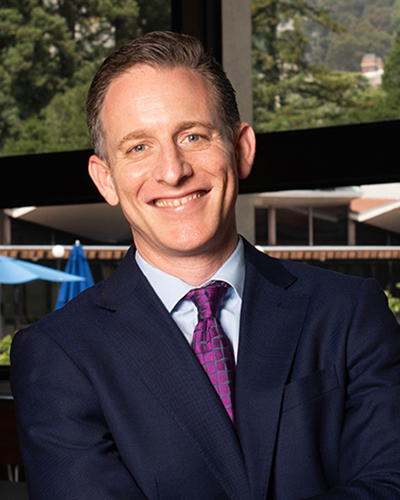
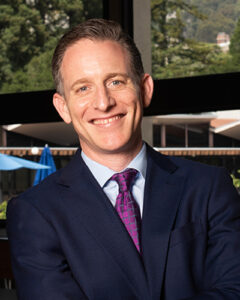 I couldn’t be happier to welcome you to this, one of the first programs of Cal Performances’ remarkable 2022–23 season. This month, we look forward to visits from gifted classical artists like violinist Maxim Vengerov and pianist Polina Osetinskaya; Baroque violinist Rachell Ellen Wong and her partners, cellist Coleman Itzkoff and harpsichordist David Belkovski; and harpsichordist and fortepianist Kristian Bezuidenhout. We’ll also welcome our own San Francisco Symphony back to UC Berkeley in a special concert especially appropriate for the Halloween season and featuring music director Esa-Pekka Salonen and piano soloist Bertrand Chamayou; as well as the brilliant Cloud Gate Dance Theatre of Taiwan with its breathtaking production of 13 Tongues. I’m proud to launch the season with programming that represents the finest in dance and classical music.
I couldn’t be happier to welcome you to this, one of the first programs of Cal Performances’ remarkable 2022–23 season. This month, we look forward to visits from gifted classical artists like violinist Maxim Vengerov and pianist Polina Osetinskaya; Baroque violinist Rachell Ellen Wong and her partners, cellist Coleman Itzkoff and harpsichordist David Belkovski; and harpsichordist and fortepianist Kristian Bezuidenhout. We’ll also welcome our own San Francisco Symphony back to UC Berkeley in a special concert especially appropriate for the Halloween season and featuring music director Esa-Pekka Salonen and piano soloist Bertrand Chamayou; as well as the brilliant Cloud Gate Dance Theatre of Taiwan with its breathtaking production of 13 Tongues. I’m proud to launch the season with programming that represents the finest in dance and classical music.

